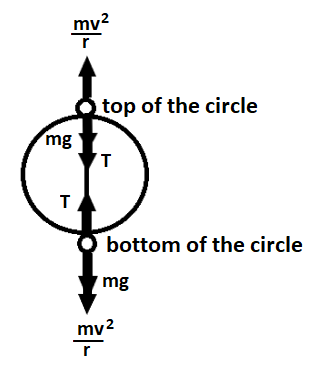Answer
64.8k+ views
Hint: The best approach to solve these types of questions in which tension is asked, first of all draw a free body diagram. After drawing a free body diagram, write the related equations and then try to solve it. After solving the equation in a simpler form, substitute the given values.
Complete step by step solution:
Given: Mass of the body, ${{m = 0}}{{.4 kg}}$
As the body is making 3 revolutions per second so time period, ${{T = }}\dfrac{{{1}}}{{{3}}}{{ sec}}$
Radius of the circle, ${{r = 1}}{{.2 m}}$
In order to find the tension in the string first we need to calculate angular velocity and the formula of angular velocity is given by
${{\omega = }}\dfrac{{{{2\pi }}}}{{{T}}}$
Now, on substituting the value of time-period in above formula, we get
$
{{\omega = }}\dfrac{{{{2\pi }}}}{{\dfrac{1}{2}}} \\
\therefore {{\omega = 4\pi rad }}{{{s}}^{ - 1}} $

(i) To find the tension in the string at the top of the circle
$\Rightarrow {{T = }}\dfrac{{{{m}}{{{v}}^{{2}}}}}{{{r}}}{{ - mg}}$
The above relation can be written in the form of angular velocity as
$\Rightarrow {{T = mr}}{{{\omega }}^{{2}}}{{ - mg}}$
On taking term “m” common, the above relation can be rewritten as
$\Rightarrow {{T = m(r}}{{{\omega }}^{{2}}}{{ - g)}}$
On substituting the values, we get
\[
\Rightarrow {{T = 0}}{{.4[1}}{{.2 \times (4\pi }}{{{)}}^{{2}}}{{ - 9}}{{.8]}} \\
\therefore {{T = 71}}{{.8 N}} \]
(ii) To find the tension in the string at the bottom of the circle
$\Rightarrow {{T = }}\dfrac{{{{m}}{{{v}}^{{2}}}}}{{{r}}}{{ + mg}}$
The above relation can be written in the form of angular velocity as
$\Rightarrow {{T = mr}}{{{\omega }}^{{2}}}{{ + mg}}$
On taking term “m” common, the above relation can be rewritten as
$\Rightarrow {{T = m(r}}{{{\omega }}^{{2}}}{{ + g)}}$
On substituting the values, we get
\[
\Rightarrow {{T = 0}}{{.4[1}}{{.2 \times (4\pi }}{{{)}}^{{2}}}{{ + 9}}{{.8]}} \\
\therefore {{T = 79}}{{.6 N}} \]
Thus, tension in the string at the top of the circle is ${{71}}{{.8 N}}$ and tension in the string at the bottom of the circle is ${{79}}{{.8 N}}$.
Note: The tension force points towards the center of the circle the entire time because tension can only act along the cord which is always a radius of the circle. Therefore in the free body diagram tension always acts towards the center of the circle for both the cases i.e. for top of the circle and for bottom of the circle.
Complete step by step solution:
Given: Mass of the body, ${{m = 0}}{{.4 kg}}$
As the body is making 3 revolutions per second so time period, ${{T = }}\dfrac{{{1}}}{{{3}}}{{ sec}}$
Radius of the circle, ${{r = 1}}{{.2 m}}$
In order to find the tension in the string first we need to calculate angular velocity and the formula of angular velocity is given by
${{\omega = }}\dfrac{{{{2\pi }}}}{{{T}}}$
Now, on substituting the value of time-period in above formula, we get
$
{{\omega = }}\dfrac{{{{2\pi }}}}{{\dfrac{1}{2}}} \\
\therefore {{\omega = 4\pi rad }}{{{s}}^{ - 1}} $

(i) To find the tension in the string at the top of the circle
$\Rightarrow {{T = }}\dfrac{{{{m}}{{{v}}^{{2}}}}}{{{r}}}{{ - mg}}$
The above relation can be written in the form of angular velocity as
$\Rightarrow {{T = mr}}{{{\omega }}^{{2}}}{{ - mg}}$
On taking term “m” common, the above relation can be rewritten as
$\Rightarrow {{T = m(r}}{{{\omega }}^{{2}}}{{ - g)}}$
On substituting the values, we get
\[
\Rightarrow {{T = 0}}{{.4[1}}{{.2 \times (4\pi }}{{{)}}^{{2}}}{{ - 9}}{{.8]}} \\
\therefore {{T = 71}}{{.8 N}} \]
(ii) To find the tension in the string at the bottom of the circle
$\Rightarrow {{T = }}\dfrac{{{{m}}{{{v}}^{{2}}}}}{{{r}}}{{ + mg}}$
The above relation can be written in the form of angular velocity as
$\Rightarrow {{T = mr}}{{{\omega }}^{{2}}}{{ + mg}}$
On taking term “m” common, the above relation can be rewritten as
$\Rightarrow {{T = m(r}}{{{\omega }}^{{2}}}{{ + g)}}$
On substituting the values, we get
\[
\Rightarrow {{T = 0}}{{.4[1}}{{.2 \times (4\pi }}{{{)}}^{{2}}}{{ + 9}}{{.8]}} \\
\therefore {{T = 79}}{{.6 N}} \]
Thus, tension in the string at the top of the circle is ${{71}}{{.8 N}}$ and tension in the string at the bottom of the circle is ${{79}}{{.8 N}}$.
Note: The tension force points towards the center of the circle the entire time because tension can only act along the cord which is always a radius of the circle. Therefore in the free body diagram tension always acts towards the center of the circle for both the cases i.e. for top of the circle and for bottom of the circle.
Recently Updated Pages
Write a composition in approximately 450 500 words class 10 english JEE_Main

Arrange the sentences P Q R between S1 and S5 such class 10 english JEE_Main

What is the common property of the oxides CONO and class 10 chemistry JEE_Main

What happens when dilute hydrochloric acid is added class 10 chemistry JEE_Main

If four points A63B 35C4 2 and Dx3x are given in such class 10 maths JEE_Main

The area of square inscribed in a circle of diameter class 10 maths JEE_Main

Other Pages
Excluding stoppages the speed of a bus is 54 kmph and class 11 maths JEE_Main

In the ground state an element has 13 electrons in class 11 chemistry JEE_Main

Electric field due to uniformly charged sphere class 12 physics JEE_Main

A boat takes 2 hours to go 8 km and come back to a class 11 physics JEE_Main

According to classical free electron theory A There class 11 physics JEE_Main

Differentiate between homogeneous and heterogeneous class 12 chemistry JEE_Main



